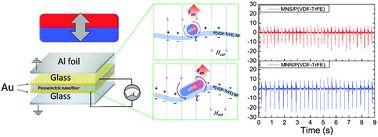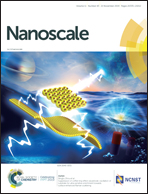Utilization of a magnetic field-driven microscopic motion for piezoelectric energy harvesting†
Abstract
In spite of the recent advances in the development of high performing piezoelectric materials, their applications are typically limited to the direct conversion of mechanical impact energy to electrical energy, potentially risking mechanical failures. In this study, we developed piezoelectric poly(vinylidenefluoride-trifluoroethylene) (P(VDF-TrFE)) nanofibers integrated with SiO2-shelled Fe3O4 magnetic nanoparticles, to utilize magnetic energy to reliably drive the piezoelectric effect. Specifically, we show that the shape of the magnetic nanoparticles exerts a significant effect on the efficiency of the magneto–mechano–electrical energy conversion as magnetic nanorods exhibit approximately 70% enhancement in electric field generation under cyclic magnetic fields as compared to nanospheres. Under an alternating magnetic field of 200 mT, the magnetic nanorod–piezoelectric nanofiber composite generated a peak-to-peak voltage of approximately 30 mVp–p with a superior durability without any performance degradation after over 1 million cycles. This study demonstrates the potential of magnetic-field responsive, piezoelectric-based materials in energy harvesting applications from non-mechanical energy sources.



 Please wait while we load your content...
Please wait while we load your content...